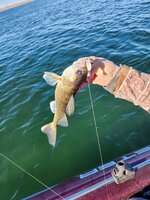RockGeo
Member
I realize that this thread has been going on for many years but I find the subject very interesting. Several years ago I emailed Larry Myhre, a retired outdoor writer from Iowa, about Caps jigs and I am posting Larry's reply plus a picture he sent me. Hopefully this will be of interest to some old timers out here. Larry wrote for the Sioux City Journal for many years. Unfortunately, you have to subscribe to get his articles. Here is Larry's email:
Back in the early 1970 I asked Cap, Lacey Gee and Jim Stone to tie up patterns of their jigs so I could mount them in a frame for display. A photo of that is attached.
You will not find any commercial jig molds which will be exactly like Cap's. But I would select a mold that uses an O'Shaughnessy hook style. Cap's original hooks were 4X long shanks made for him by Mustad, but that hook has long been discontinued. We used to bend our own from streamer hooks, but I finally converted my jig molds to the O'Shaughnessy style. The key to tying Rock-A-Roos is to not tie the chenille all the way up to the head. Stop a short ways back, this gives the bucktail more room and it won't flare away from the body. HIs wife Kathy always tied the tail and body and Cap added the bucktail. Cap always used fluorescent chenille for his bodies. Fluorescent chenille is hard to find in all colors, especially white, but barlowstackle.com carries it. No. 4 would be the largest. Probably get a five-yard card of each size to start with. White (506), chartreuse (502) and (501) would tie a lot of Cap's jigs. Jim Stone, Warden's Worry, Mary Kay and Blue Tail were his most popular patterns. We tied these jigs down to 1/16 ounce substituting hackle fibers or badger underfur instead of bucktail for the 1/16th size. Another key to tying bucktail is to tie tightly at the beginning of the wrap and then use only enough pressure to hold the bucktail down near the head of the jig. We never trimmed the butts of the bucktail after the jig was tied. We cut the hair to the proper length and then tied it in.
If you Google "g-whiz jigs" you will find a couple of articles I wrote about Lacey's jigs.
Larry is still writing outdoor articles at https://garyhoweysoutdoors.com/tricks-for-finicky-late-season-fish-by-larry-myhre/.
Back in the early 1970 I asked Cap, Lacey Gee and Jim Stone to tie up patterns of their jigs so I could mount them in a frame for display. A photo of that is attached.
You will not find any commercial jig molds which will be exactly like Cap's. But I would select a mold that uses an O'Shaughnessy hook style. Cap's original hooks were 4X long shanks made for him by Mustad, but that hook has long been discontinued. We used to bend our own from streamer hooks, but I finally converted my jig molds to the O'Shaughnessy style. The key to tying Rock-A-Roos is to not tie the chenille all the way up to the head. Stop a short ways back, this gives the bucktail more room and it won't flare away from the body. HIs wife Kathy always tied the tail and body and Cap added the bucktail. Cap always used fluorescent chenille for his bodies. Fluorescent chenille is hard to find in all colors, especially white, but barlowstackle.com carries it. No. 4 would be the largest. Probably get a five-yard card of each size to start with. White (506), chartreuse (502) and (501) would tie a lot of Cap's jigs. Jim Stone, Warden's Worry, Mary Kay and Blue Tail were his most popular patterns. We tied these jigs down to 1/16 ounce substituting hackle fibers or badger underfur instead of bucktail for the 1/16th size. Another key to tying bucktail is to tie tightly at the beginning of the wrap and then use only enough pressure to hold the bucktail down near the head of the jig. We never trimmed the butts of the bucktail after the jig was tied. We cut the hair to the proper length and then tied it in.
If you Google "g-whiz jigs" you will find a couple of articles I wrote about Lacey's jigs.
Larry is still writing outdoor articles at https://garyhoweysoutdoors.com/tricks-for-finicky-late-season-fish-by-larry-myhre/.






